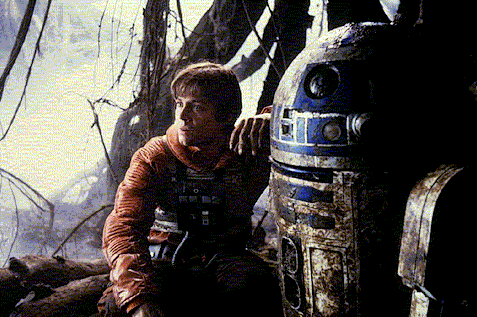 The Empire Strikes Back
The Empire Strikes Back
 The Empire Strikes Back
The Empire Strikes Back

Roger Ebert Review:
THE EMPIRE STRIKES BACK is the best of three STAR WARS films, and the most thought-provoking. After the space-opera cheerfulness of the original film, this one plunges into darkness and even despair, and surrenders more completely to the underlying mystery of the story. It is because of the emotions stirred in EMPIRE that the entire series takes on a mythic quality that resonates back to the first and ahead to the third. This is the heart.
The film was made in 1980 with full knowledge that STAR WARS had become the most successful film of all time. If corners were cut in the original budget, no cost was spared in this one, and it is a visual extravaganza from beginning to end, one of the most visionary and inventive of all films.
Entirely apart from the story and the plot, the film is worth seeing simply for its sights. Not for the scenes of space battle, which are more or less standard (there's nothing here to match the hurtling chase through the high walls of the Death Star). But for such sights as the lumbering, elephant-like Imperial Walkers (was ever a weapon more impractical?). Or for the Cloud City, on its spire high in the sky. Or for the face of a creature named Yoda, whose expressions are as convincing as a human's, and as subtle. Or for the dizzying, vertiginous heights that Luke Skywalker dangles over, after nearly plunging to his death.
There is a generosity in the production design of THE EMPIRE STRIKES BACK. There are not only the amazing sights there before us, but plenty more in the corners of the screen, or everywhere the camera turns. The whole world of this story has been devised and constructed in such a way that we're not particularly aware of sets or effects—there's so much of this world that it all seems seamless. Consider, for example, an early scene where an Empire "probe droid" is fired upon on the ice planet Hoth. It explodes. We've seen that lots of times. But then hot pieces of it shower down on the snow in the foreground, in soft, wet plops. That's the kind of detail that George Lucas and his team live for.
There is another moment. Yoda has just sent Luke Skywalker into a dark part of the forest to confront his destiny. Luke says a brave farewell. There is a cut to R2D2, whirling and beeping. And then a cut back to Yoda, whose face reflects a series of emotions: concern, sadness, a hint of pride. You know intellectually that Yoda is a creature made by Frank Oz in a Muppet shop. But Oz and Lucas were not content to make Yoda realistic. They wanted to make him a good actor, too. And they did; in his range of wisdom and emotion, Yoda may actually give the best performance in the movie.
The worst, I'm afraid, is Chewbacca's. This character was thrown into the first film as window dressing, was never thought through, and as a result has been saddled with one facial expression and one mournful yelp. Much more could have been done. How can you be a space pilot and not be able to communicate in any meaningful way? Does Han Solo really understand Chewie's monotonous noises? Do they have long chats sometimes?
Never mind. The second movie's story continues the saga set up in the first film. The Death Star has been destroyed, but Vader, of course, escaped, and now commands the Empire forces in their ascendancy against the Rebels. Our heroes have a secret base on Hoth, but flee it after the Empire attack, and then the key characters split up for parallel stories. Luke and R2D2 crash-land on the planet Dagobah and Luke is tutored there by Yoda in the ways of the Jedi and the power of the Force. Princess Leia, Han Solo, Chewbacca, and C3PO evade Empire capture by hiding their ship in plain sight, and then flee to the Cloud City, ruled by Lando (Billy Dee Williams), an old pal of Han's and (we learn) the original owner of the Millennium Falcon, before an unlucky card game.
Home